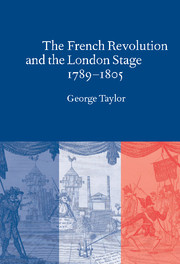Book contents
- Frontmatter
- Dedication
- Contents
- Acknowledgements
- Note on the text
- Introduction
- 1 England and France in 1789
- 2 The Revolution
- 3 From the Federation to the Terror
- 4 Dramatising (the) Terror
- 5 Performance and performing
- 6 The Shadow of Napoleon
- 7 Theatre and alienation
- Reflections towards a conculsion
- Notes
- Bibliography
- Index
3 - From the Federation to the Terror
Published online by Cambridge University Press: 05 July 2014
- Frontmatter
- Dedication
- Contents
- Acknowledgements
- Note on the text
- Introduction
- 1 England and France in 1789
- 2 The Revolution
- 3 From the Federation to the Terror
- 4 Dramatising (the) Terror
- 5 Performance and performing
- 6 The Shadow of Napoleon
- 7 Theatre and alienation
- Reflections towards a conculsion
- Notes
- Bibliography
- Index
Summary
Although during 1789 and 1790 there had been a widespread welcome in Britain for the Revolution, in 1791 attitudes began to polarise as France continued to drive out émigrés, bringing tales of persecution, and advocate revolution in neighbouring states, while failing to bring its own constitutional debates to a settled conclusion. In October 1791 the new constitution had been promulgated, but, although Louis XVI had been proclaimed chief executive, with the power to appoint ministers and a royal veto over the Legislative Assembly, after his flight to Varennes his support for it was very suspect.Separating the powers of the executive and legislature may have served the Americans well, but in France it led to a rivalry between the Assembly and the king's ministers — complicated by the power of the Paris Commune and the Revolutionary clubs to organise direct action within the capital — and out of this confusion came the declaration of war against Austria on 20 April 1792. Aristocrat émigrés, including the king's own bothers, had gathered in the Rhineland cities of Coblenz and Trier and were threatening to create a counter-revolutionary army with the support of Leopold II of Austria — Marie Antoinette's brother — and Frederick William II of Prussia.
- Type
- Chapter
- Information
- The French Revolution and the London Stage, 1789–1805 , pp. 68 - 96Publisher: Cambridge University PressPrint publication year: 2001



